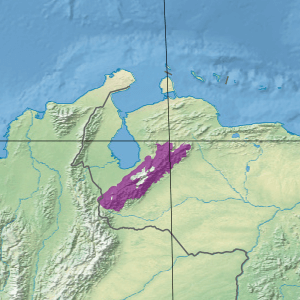The Venezuelan Andes Montane Forests: A Biological Treasure Trove
Nestled within the northern arm of the Venezuelan Andes, a northeastern branch of the mighty Andes Mountains system, lies the Venezuelan Andes montane forests ecoregion – a verdant tapestry of towering peaks, misty cloud forests, and a staggering array of plant and animal life.
The Venezuelan Andes Montane Forests: A Biological Treasure Trove
Nestled within the northern arm of the Venezuelan Andes, a northeastern branch of the mighty Andes Mountains system, lies the Venezuelan Andes montane forests ecoregion – a verdant tapestry of towering peaks, misty cloud forests, and a staggering array of plant and animal life. This unique ecosystem, separated from the Eastern Andes of Colombia by the Tachira depression, is a true gem, a testament to the incredible biodiversity that thrives in the heart of South America.
Geographic Setting
A Patchwork of Ecosystems
The Venezuelan Andes montane forests ecoregion is a mosaic of diverse landscapes, bordered by various ecosystems that underscore its exceptional character. To the southeast, it adjoins the Llanos and the Apure-Villavicencio dry forests, while to the southwest, it borders the Cordillera Oriental montane forests. In the northwest, it meets the Catatumbo moist forests and the Maracaibo dry forests, and to the north, it merges with the Paraguana xeric scrub and La Coast xeric shrublands.
The Tamá Massif
Additionally, the ecoregion encompasses the forests surrounding the Tamá Massif, a relatively isolated montane area between the Eastern Andes of Colombia and the Táchira depression, further contributing to its unique ecological character.
Altitudinal Zonation
Evergreen Transition Forests
The Venezuelan Andes montane forests ecoregion occupies the middle elevations of the mountain range, with evergreen transition forests found at altitudes between 800 and 2,000 meters (2,600 - 6,600 feet). Species from the Lauraceae, Moraceae, Myrtaceae, Bignomiaceae, Euphorbiaceae, and Araliaceae families dominate these dense, middle-to-high vegetation forests.
Evergreen Montane Cloud Forests
The evergreen montane cloud forests take over at higher elevations, ranging from 2,000 to 3,000 meters (6,600 to 9,800 feet). These towering forests, with their abundant understory and rich diversity of epiphytes, are dominated by species such as the pino de pasto, Mexican alder, Ruagea glabra, Oreopanax moritzii, and Weinmannia jahnii.
Climate and Weather Patterns
The climate of the Venezuelan Andes montane forests ecoregion is heavily influenced by the northeastern trade winds, particularly during the dry season from December to April. The inter-tropical convergence zone brings the region's highest rainfall from April to November, with annual precipitation ranging from 2,000 to 3,000 millimeters (80 to 120 inches), although this can vary significantly.
Biodiversity Hotspot
A Wealth of Species
Surrounded by inter-Andean xeric valleys and páramo ecosystems, the Venezuelan Andes montane forests ecoregion boasts an exceptional richness of plant and animal species, including many endemics, making it one of the most biologically interesting areas of Venezuela.
Flora Diversity
The regional flora of the Venezuelan Andes is extraordinarily diverse, with vegetation ranging from the dense, multi-layered evergreen transition forests found between 800 and 2,000 meters (2,600 and 6,600 feet) to the very dense, epiphyte-rich cloud forests found at higher elevations between 2,000 and 3,000 meters (6,600 and 9,800 feet).
Fauna Endemism
The ecoregion's faunal diversity is equally impressive. There are 25 restricted-range endemic bird species and four endemic mammal species, including a marsupial (Gracilinanus dryas), a bat (Anoura luismanueli), a rat (Thomasomys vestitus), and a poorly known fish-eating rat (Neusticomys mussoi), and a significant number of endemic frog species.
Threatened Species
One species of particular concern is the spectacled bear (Tremarctos ornatus), an endangered mammal widely distributed throughout the Andes, from Colombia and Venezuela to Ecuador, Peru, and Bolivia.
Conservation Challenges
Agricultural Expansion
The expansion of agriculture into the Venezuelan Andes montane forests ecoregion represents the most significant threat to this fragile ecosystem. Most slopes have already been converted for agricultural purposes, giving the ecoregion's montane forests a patchwork appearance.
Preserving a Biological Treasure
Efforts to preserve the remaining intact areas of this ecoregion are crucial to safeguarding its exceptional biodiversity. By promoting sustainable land-use practices, establishing protected areas, and raising awareness about the importance of this unique ecosystem, we can ensure that the Venezuelan Andes montane forests continue to thrive as a biological treasure trove for generations to come.
Conclusion
The Venezuelan Andes montane forests ecoregion is a true ecological gem. It is a place where the majesty of the Andes meets the incredible diversity of life that has evolved within its rugged peaks and misty valleys. From its towering cloud forests and dense evergreen thickets to its wealth of endemic species and threatened wildlife, this ecoregion stands as a testament to the invaluable natural heritage of Venezuela and the broader Andean region.

Map depicting the location of the Venezuela Andes montane forests (in purple).
